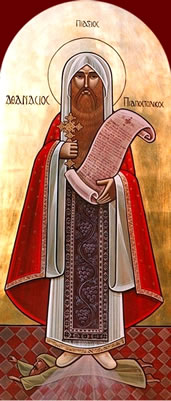Jerome, Dialogue Against the Luciferians 19b-20a
| Reference | CPL 608 |
| Date | Pre-382 |
| Latin Text | Patrologia Latina vol. 23, coll. 153-182B. ed. J.P. Migne, (Paris, 1883). |
| English Translation | W.H. Fremantle (NPNF2, 6:319-34), updated by FCC (AGC). |
Jerome’s short account of the first Nicene council is part of his much longer work in which an unnamed orthodox “son of the church”1 (O) argues against Helladius, a follower of Lucifer of Cagliari (L) who refused to accept penitent Arian bishops as bishops in the orthodox church. Helladius’ arguments are silenced by section 14 of Jerome’s account, but he wants evidence that it had been the historic practice of the Church to accept penitent heretics even into church leadership positions. Naturally, the conversation about historic Arianism leads to the council of Nicaea, where we can see a short list of some of the Arian bishops at the council and a reference to the minutes and list of subscribers.
| Latin | English |
| 19b O. Nam cum in synodo Nicaena, quae propter Arianam perfidiam congregata est, octo episcopos Arianos susceptos sciamus; et episcopus iam in mundo nullus sit, nisi quos synodus illa odinavit: quomodo potuerunt adversum eam facere, propter quam exsilium sustinuerunt? | 19b O. …We know that at the Council of Nicaea, which was assembled on account of the Arian treachery, eight Arian bishops were welcomed, and there is not a bishop in the world at the present day whose ordination is not dependent on that Council. This being so, how could they act in opposition to it, when their loyalty to it had cost them the pain of exile? |
| 20 L. An tandem et tunc recepti sunt Ariani? Quinam, quaeso? | 20 L. Were Arians really then received after all? Please tell me who they were. |
| O. Eusebius episcopus Nicomediensis, Theognius episcopus Nicaenus. Saras tunc presbyter Libyae. Eusebius episcopus Caesareae Palestinae, et reliqui, quos enumerare longum est. Ipse quoque caput horum et causa malorum, Arius presbyter, et Euzoius diaconus, qui post Eudoxium Antiochenus episcopus fuit; et Achillas lector. Hi quippe tres Alexandrinae Ecclesia clerici, auctores huius haereseos exstiterunt. | O. Eusebius, bishop of Nicomedia, Theognis, bishop of Nicaea, Saras, at the time presbyter of Libya, Eusebius, bishop of Caesarea in Palestine, and others whom it would be tedious to enumerate; Arius also, the presbyter, the original source of all the trouble; Euzoius the deacon, who succeeded Eudoxius as bishop of Antioch, and Achillas, the reader. These three who were clerics of the Church of Alexandria were the originators of the heresy. |
| L. Si quispiam eos neget fuisse susceptos, quomodo revincetur? | L. Suppose a person were to deny that they were welcomed back, how is he to be refuted? |
| O. Supersunt adhuc homines qui illi synodo interfuerunt. Et si hoc parum est, quia propter temporis antiquitatem rari admodum sunt, et in omni loco testes adesse non possunt, legamus acta et nomina episcoporum synodi Nicaenae; et hos quos supra diximus fuisse susceptos, subscripsisse homusion, inter caeteros reperiemus. | O. There are men still living who took part in that council. And if that is not enough (because they are but few, owing to the time that has elapsed, and because it is impossible for witnesses to be everywhere), if we read the acts and names of the bishops of the Council of Nicaea we find that those who we referred to above were welcomed back and did subscribe to the homoousion along with the rest. |
This work is licensed under CC BY-NC-SA 4.0
Other works by Jerome
Back to Ancient Descriptions of the Council of Nicaea
Last updated 11/1/24 by GLT.
No Responses yet
